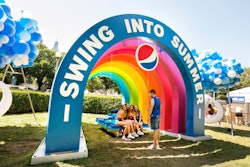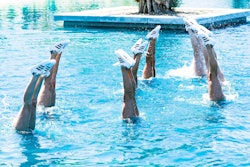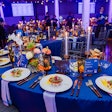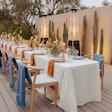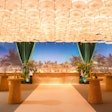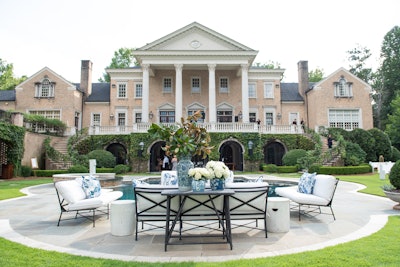
Planning an outdoor event during the dog days of summer? Let’s be real: It’s not for the faint of heart. Between scorching temperatures, unpredictable storms, and the constant quest to keep guests cool and comfortable, summer events demand extra thought and strategy.
That’s why we turned to someone who thrives in the thick of it—literally. Frank Carlisi, director of design at Bold Catering & Design in Atlanta, spends his summer months transforming hot, sticky environments into stunning, guest-friendly experiences.
“It’s 100 degrees here in Atlanta right now, and we’ve got trucks going out all over the place,” he told us on a recent phone call. “One’s even headed all the way to Wisconsin for an event—in an un-airconditioned airport hangar where it’s also going to be 100 degrees. So it’s all very fresh in my brain.”
Here, Carlisi shares his top strategies for pulling off outdoor events when the weather is working against you—and how to make them look effortless in the process.
1. Be strategic with venue choice.
Your event’s success starts with where it’s held. “It really comes down to location, location, location,” says Carlisi. “Knowing your resources when you're choosing a site is key. A lot of times, as designers, we’re involved in that decision-making process, which is helpful. My background is in event planning—and believe it or not, I’m also a classically trained French chef, so I tend to look at the whole event holistically."
He adds, “An outdoor event in Atlanta, for example, definitely has its challenges, but it also opens the door to creativity. First and foremost, choose a location where you can offer respite for guests—whether that’s shade elements, indoor-outdoor flow, or partial coverage. It’s all about asking: How many options do we have, and how many ways can we use the space creatively?”
2. Always have a backup plan—and don’t turn your nose up at tents!
Rain, heat, or humidity—weather will almost always surprise you. That’s why Carlisi never skips the contingency plan.
“I’m a chronic over-planner, and in Georgia, it rains almost every day around 4 p.m. Torrential!” he says. “So we always try to put up a tent, even if the client doesn’t think they need one. I’ll try to guide them in that direction.” Another must? Flooring. “When it rains heavily, water can pool under the tent. A lot of people opt out of flooring, but it can ruin an event,” he adds.
From there, treat the tent as an extension of your overall concept. “It shouldn’t feel like just four white walls; we want the design to feel intentional and integrated with the theme of the event.”  "Design your color palette to complement the natural light," he says. "It's a beautiful, cost-effective way to enhance ambiance."Photo: Jeremy Harwell
"Design your color palette to complement the natural light," he says. "It's a beautiful, cost-effective way to enhance ambiance."Photo: Jeremy Harwell
3. Consider your timing.
Schedule smart: Hosting your event during golden hour is not only cooler; it also delivers stunning lighting and an instant sense of ease for your guests. Carlisi’s pro tip? Start the event right before sunset, so people arrive with a cocktail in hand and settle in as the sky turns to magic.
“Think of golden hour as a decor element!” he says. “Design your color palette to complement the natural light. It's a beautiful, cost-effective way to enhance ambiance. Nature should inform your design aesthetic.”
4. Shade is not optional, but it can be beautiful.
Shade doesn’t just help with comfort—it can be a design moment. From oversize umbrellas to draped fabric to towering tree installations, Carlisi recommends creating natural breaks from the sun that are as stylish as they are functional. “Use decor that works overtime,” he says. “If you’re paying for it, it should serve a purpose.”
Carlisi tries to think big when it comes to shade structures. “We’ll bring in large tree installations or build big branch elements,” he explains. “They add beauty while serving a function. We also use the top of tents to hang structures that provide coverage—like greenery or fabric installations that block sunlight but look seamless."
And don’t forget the team behind the scenes! “A bartender stuck outside in the sun for six hours? Not okay. So maybe the bar structure has a canopy, or we add shade around the prep areas. At Bold, we’re always looking at the whole picture—guests, staff, everyone.”
5. Be intentional about F&B.
Menus should reflect the season—think grilled peach skewers, ceviche in citrus cups, or frozen mojitos passed in lime rinds. “I’ve done a lot of events in the Hamptons, and I bring that mindset to Atlanta,” Carlisi says. “Keep it light. We’re not serving beef bourguignon in July."
One of his go-to tricks? Tie the menu into the decor. “If we have a big tree structure, we might do an agua fresca station under it—flavored with lime, apple, or whatever ties into the visual design.”
He also favors Mediterranean flavors, fresh herbs, and chilled or frozen options. “It’s all about creating palate-cleansing, creative experiences,” he says. “And if we're doing buffets or food stations outdoors, we always build in shade. We’ll use our tree structures or other elements to keep food cool and safe.”  “Use decor that works overtime. If you’re paying for it, it should serve a purpose," says Carlisi.Photo: Jeremy Harwell
“Use decor that works overtime. If you’re paying for it, it should serve a purpose," says Carlisi.Photo: Jeremy Harwell
6. Let guests know what to expect.
One of the simplest ways to elevate your event? Help guests arrive prepared. “Include language in the invite,” Carlisi advises. “There’s nothing worse than being surprised and sweating through your outfit.”
He recommends playful but clear dress codes like Creative Cocktail Summer Attire. “Think a DVF wrap dress or linen suits. You can be playful while still setting the right expectations.”
And don’t skip the footwear PSA. “No stilettos in the grass,” he warns. “If you’re planning an outdoor event, let people know. Add something cheeky in the invite like, ‘Leave the heels at home.’ It makes a big difference in their experience.”
7. Add thoughtful touches.
Small gestures go a long way when the temperature’s climbing. “If the budget allows, we’ll add a little fan as part of the invitation suite,” Carlisi says. “For one wedding, we lined the red carpet with parasols that guests could grab. It’s those thoughtful touches that show your guests they were considered in the planning process.”
And don’t overlook bug control. “Citronella can be chic!” he argues. “Lanterns work beautifully—there are so many elegant versions now that don’t scream ‘tiki torch.’ We’ve used lavender-scented citronella candles, too. You don’t need the backyard barbecue smell.”
His go-to add-on? A chilled lavender towel paired with a custom mini bottle of bug spray. “It’s about creating sensory moments that serve a function and elevate the guest experience.”




